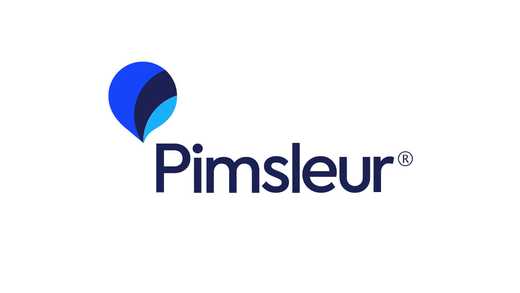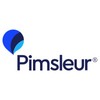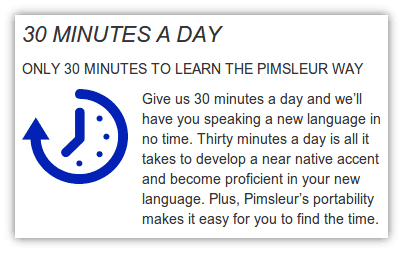The Most Honest Pimsleur Review You'll Ever Read
 Written byHubert Nagel
Written byHubert Nagel- Read time16 mins
- Comments112


- Research-backed, proven method
- Effective spaced repetition system
- Affordable with new subscription model
- Audio only
- Dated social scenarios
- Unsuitable for higher levels
Pimsleur is a timeless classic that, after many decades, remains a viable and highly effective tool for language learning. One of the few methods with solid research behind it and proven results.
Hit the green button to use Pimsleur for free (for 7 days).
“Practically everybody believes that learning must build up gradually from the simple to the complex… My principle is this: Learn the hardest thing first and the rest will then seem easy.”
– Paul Pimsleur
UPDATE: For a much more comprehensive audio course alternative to the Pimsleur series (and more affordable), I recommend the Rocket Language series. The dialogues and pronunciation are higher quality, a wider range of content and topics are covered in detail and all the audio is 100% downloadable (see my review here).
Select the language you’re learning to see what it’s all about:
I’ve also listed some excellent alternative resources on my Essential Language Learning Tools page to help you.
Pimsleur is one of the longest and most well-established household names in language learning – right up there with other commercial giants like Rosetta Stone and Michel Thomas.
Questions about whether or not Pimsleur works do tend to pop up all over the place and a simple online search yields a lot of review and opinion pieces on it.
As I said in my Rosetta Stone review, nearly all of the search results that you’ll find online for Pimsleur are totally suspect because they’re either motivated solely by commission rates for selling it or trying to deceive you into buying something else by dismissing it.
Very few reviews actually go into real depth to cover its content and effectiveness with fairness.
This review will do that.
For the purpose of making a comprehensive analysis of the Pimsleur MethodTM, I’ve sampled two editions of languages that I know extremely well (Egyptian and “Eastern” Arabic), three that I know quite well (Korean, Russian and Irish), and one language that I know absolutely nothing about (Thai) to put myself in the position of a new learner.
I’ve also studied the book How To Learn A Foreign Language by Paul Pimsleur himself which gives a lot more insight into his method.
There are some new software packages available on the Simon and Schuster site but it seems to be the original Pimsleur MethodTM + flash card and game apps.
This post will deal the core product and method of Pimsleur only.
WARNING: Pimsleur.com is the real site – Pimsleurapproach.com is a scam. It’s called the ‘Pimsleur MethodTM’, not ‘Pimsleur Approach’.
Before we go any further, pay careful attention to this.
There are countless complaints online from people who signed up to a bogus site (that looks incredibly professional and real) which hooks people into a recurring billing cycle.
Simon and Schuster (who own and distribute Pimsleur) use a trademark name calling it the Pimsleur MethodTM (hence the trademark symbol).
Anything calling itself the ‘Pimsleur Approach’ is fake and run by sneaky affiliates.
Only ever use the official website.
You’ll find other bogus domains that are just as bad, run by affiliate spammers (e.g. pimsleuraudio, pimsleurunlimited and so on).
Be smart
Now on to the review…
Pimsleur is not just a learning tool – it’s a method
Let’s deal with the most important thing first.
One of the terms that gets thrown around a lot in language learning discussions is ‘Spaced Repetition System’ (or SRS). I feel it’s one of those terms which everybody knows is a good thing but most don’t actually understand what it means.
So I’ll explain it to you in the simplest way possible by way of example:
You’re learning a foreign language.
You come across a brand new word that you’ve never seen before.
You forget it almost immediately.
One hour later, you see it again.
It’s familiar to you but you can’t remember it until the answer’s shown.
A few hours go by and you forget it again.
The next day, you see it again.
This time it’s very familiar but you still can’t remember it until it’s shown.
Three days later you’re shown the word again.
Finally you remember the word.
Now that’s a really simplified way of demonstrating how SRS works but let’s look at what’s happening here.
Each time the word is shown, there’s a larger gap between the time it’s shown and the previous time you saw it. At first you forget the word almost immediately but gradually it becomes more and more familiar until you remember it with ease.
Sometimes this happens early, sometimes it takes a lot more exposure for it to really stick.
Getting back to Pimsleur…
Paul Pimsleur developed his own version of SRS based on his research into intervals (the periods between each time a word or phrase is recalled) so the Pimsleur MethodTM adheres to a fairly rigid timeline starting with high frequency recall (in seconds and minutes) and gradually moving up to days, weeks and months.
So if you listen to a Pimsleur product, you’ll hear a word or sentence introduced for the first time and then seconds later you’ll be asked to recall it.
Then it will be minutes later, hours and so on.
Now here’s where the Pimsleur MethodTM is unique and in my opinion excellent:
Paul Pimsleur knew how important participation is in the process of language learning. Usually, when people learn with SRS they do it for memorization.
In other words, just listening or reading at spaced intervals.
Pimsleur products pressure you to recall and participate in an actual exchange.
So instead of playing a word to get you to remember it, the audio series asks you how to say something or to respond to a native speaker.
The beautiful thing about this is that it never allows you to become a passive listener.
You’re actively involved in what you’re listening to and the presenter of the series keeps you on your toes because you need to respond at various intervals. This active recollection is powerful at getting you to recall and use the language just as you would often have to do in real life situations.

If you’re interested in how this works and knowing more about it, the best explanation I’ve come across is actually by the man himself in his own book.
I’m finding Paul Pimsleur’s insights into foreign language acquisition that are in the book quite helpful.
It’s a purely audio-based method
So what does that mean for visual-spatial learners like myself?
What about people who remember things better by seeing them?
As a visual spatial learner (see my detailed post about that here), I’ve always learned better by being able to visualize what I’m learning (although I’m a huge fan of Earworms MBT which is also a similar kind of audio-based approach to language learning that uses music).
Since Pimsleur is entirely audio-based (except for a reading booklet which accounts for a small part of it), this poses the question of whether or not it’s suitable for someone who learns visually.
It actually is (at least for me personally) and I’ll explain why.
For a program that’s entirely auditory, Pimsleur is surprisingly visual in its own kind of way.
How?
First of all, the presenter gets you to imagine scenarios:
“Imagine an American man meeting an Irish woman in an area where Irish is spoken. He wants to begin a conversation…”
I didn’t realize this at first but this kind of mental imagery can actually be more stimulating for me as a visual-spatial learner than reading text on a page.
If I were to read those same lines – “Imagine an American man meeting an Irish woman…” – as words on paper or on screen, it might even distract me from visualizing it because I’d be focused more on the actual text I’m reading.
The other thing is the way the pronunciation of words is presented.
The native speakers speak the words backwards, one syllable at a time.
This actually gets you to picture and focus on each individual syllable.
We associate sounds with mental images constantly and it’s those mental images that serve in helping us to remember what we hear.
One thing I would recommend if you do use Pimsleur is to make sure you’re not preoccupied with anything while you’re listening to it (e.g. commuting) since concentration is so important.
Very polite language
I’ve found the same issue with Rosetta Stone and other products.
Just listening to Pimsleur Korean, Russian, Egyptian and Eastern Arabic, I noticed the excessively formal and polite language used in the dialogues (for example polite verb forms in Korean and plural вы pronoun in Russian).
Although it’s good practice to learn and use these forms where appropriate, in reality native speakers aren’t always this formal – especially when talking to family or strangers who are the same age or younger.
The difference between Rosetta Stone and Pimsleur though is that Rosetta Stone makes the absurd mistake of having older people address younger people and people who are friends and family addressing each other using polite forms (which is almost always not the case in reality speaking from experience living in these places).
In Pimsleur’s defense most of the dialogues are stangers addressing each other so their use of polite forms is quite justifiable.
Vocabulary is limited
One common criticism of the Pimsleur MethodTM is that it doesn’t teach enough vocabulary.
Each language series only introduces a few hundred new words in total. The exact amount depends on how many levels there are since some languages have only one level and others have three, four or five.
Here’s what the Simon and Schuster website has to say about this:
“Effective communication in any language depends on mastery of a relatively limited number of words and structures. Trying to learn too much at once substantially slows the process, and many people quickly become discouraged.
Pimsleur courses deliberately limit the amount you learn at any one time, giving your brain a chance to internalize each new item before moving on. Once this foundation is built, adding new words and phrases becomes easy and natural because there’s a clear framework to attach them to.”
Keywords here are ‘structures‘ and ‘clear framework‘.
Language products like Pimsleur aren’t meant to be exhaustive sources of vocabulary. They exist to teach you the ‘framework’ of a language so that you can do the rest on your own.
No language product or course is going to teach you every bit of vocab that you want/need.
It’s up to you to do that.
Some (but not all) language editions sound very unnatural
I can’t judge the recordings of the Thai version that I sampled but I can say some of the language versions do sound dreadfully artificial.
Both Arabic versions that I listened to made me skeptical that I was even listening to native speakers – at least a few of the voices sound very non-native.
I had my Egyptian friends listen to the Egyptian Arabic recordings and they had a bit of a giggle at how silly the voice actors sound – not just the accents but the manner in which they’re speaking.
This is unfortunately a common problem with a lot of language product dialogues in that they sound like somebody hired D grade voice actors to read the script.
On the other hand I was quite impressed by the Russian, Irish and Korean recordings which sound much better than the Arabic.
Lessons are intentionally very short

I must say that I think the way this is marketed is a bit disingenuous.
One of the biggest selling points of Pimsleur is that you only need 30 minutes a day to become proficient in a language. As someone who has learned many languages (and failed some), I can attest that this definitely not true.
30 minutes of language time doesn’t cut it.
To learn a language well in a reasonable amount of time requires hours a day consistently.
Pimsleur marketing needs to be more clear about what they mean. Are they saying that you only need 30 minutes of language time overall or 30 minutes of lesson time?
I’d like to see a link to a study that backs that claim up personally.
I am all for short study periods though.
Studying for hours on end is detrimental and you can actually retain more by focusing on a smaller amount in a short time.
As I’ve said before, it’s harder to learn 10% of 50 words than it is to learn 100% of 5 words.
But Simon and Schuster shouldn’t imply that simply putting on headphones for 30 minutes a day is all that’s required on your part as a learner.
It should be 30 minutes of Pimsleur + many hours of language use.
Its priorities are right
As I’ve already said, Pimleur is purely audio-based.
There’s no book or program to look at. You just put on your headphones, listen and repeat. So the emphasis is entirely on speaking and listening.
This is how languages should be learned.
Languages are not written. They’re spoken (or in the case of the hearing impaired, signed).
We invented writing systems as a way of representing spoken sounds on paper – not the other way round.
I think part of the problem with language education is that we’ve reduced foreign languages down to a list of rules on paper. We focus too much on the representation of what we hear when we should focus on what we hear first and worry about the representation later.
Doing so is not only a more natural way to learn but also helps with your pronunciation.
You can’t really learn to pronounce something properly by reading it. You need lots of listening and repeating.
Does its age give it authority?
I feel that this question has to be asked of all the big name products like RS, Michel Thomas and Assimil as well.
Does the fact that something’s been around for half a century add weight to its value?
You have to keep in mind that products like Pimsleur came out when cassettes were all the rage and there was no Internet or easy way to find native speakers for practice.
So it makes sense that something like Pimsleur would have been groundbreaking at the time – not just because it was an effective methodology but because it was something new that utilized the technology of the day.
And it’s true that when any brand is around long enough it gains familiarity and trust.
That being said I do actually think Pimsleur is an outstanding, timeless product.
Age aside, it’s great for what it is and even after decades remains a very unique product in a saturated market full of imitators.
Fantastic tool but it’s WAY overpriced
Pimsleur is ludicrously expensive if you buy the course outright.
It’s a fantastic product of which I have mostly good things to say about but the price is frankly extreme and completely unaffordable by ordinary people.
For example, French 1 – 5 (CD version) is currently selling for $1,190 (!!!) on the Simon and Schuster site or $550 if you take the MP3 version which is still very expensive.
They do provide a lot of different options for customers (e.g. only buying some levels or individual lessons) and you can occasionally find it cheaper on Amazon.
MAJOR UPDATE: Pimsleur have since created a subscription option with a free trial that is incredibly affordable by comparison. See here for more info.
I’ll never condone piracy on this site (especially having created my own language product and knowing how much work and love goes into making something that other people steal) but by putting price tags like that on Pimsleur, I think they’re encouraging people to do the wrong thing.
As I said in my Rosetta Stone review there is so much you can buy with that kind of money.
For example, instead of the $550 for levels 1 – 5 of Pimsleur’s French MP3’s, you could:
Get approximately 50 personalized, one-on-one lessons with native speakers on italki.
Buy a cheaper, similar audio-based product such as Earworms MBT or Glossika (review) and save the rest of your money.
Buy a more comprehensive, high quality course like Rocket Languages.
If you’re in the US or Australia you could put the money toward an actual trip to places like Latin America, Quebec, South-East Asia and so on (in the case of the $1,190 CD version you could probably buy a whole overseas trip).
If you live in Europe that kind of money would easily pay for a low-budget airline trip + hostel + food for couple of weeks to another European destination.
That money could feed you and pay your accommodation for months in the Mid East and many parts of Asia to learn the local language.
You should always consider what you could achieve with that kind of money before going out and spending it on a very expensive product.
But hey, if you’ve got the cash and you’re cool with spending it then Pimsleur is an excellent product.
It’s a tool that I would definitely recommend, especially for new learners.
The 7 day free trial is a great way to test it out without any risk too.
 Grab the link to this article
Grab the link to this article